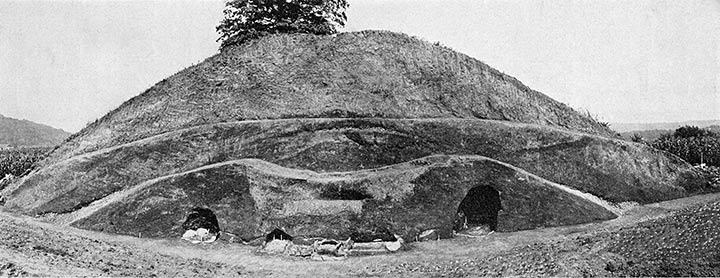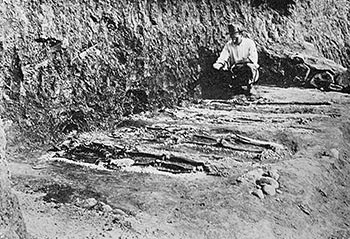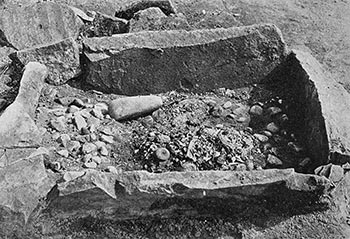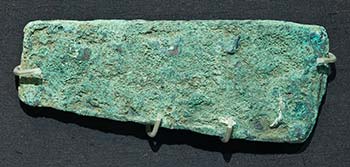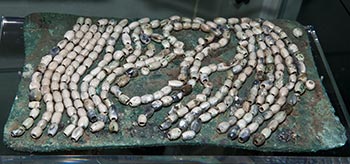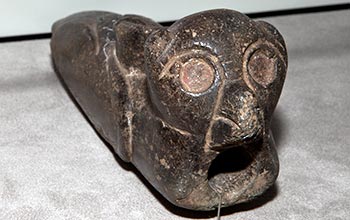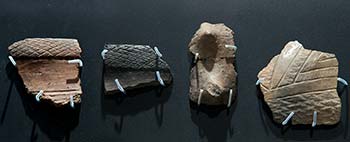
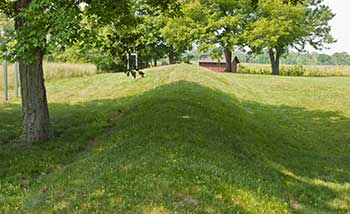
|
| Outer wall of the Seip Earthworks. |
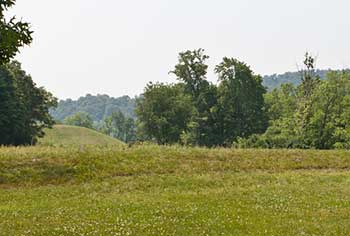
|
| Outer wall of the Seip Earthworks with Seip mound in the background. |
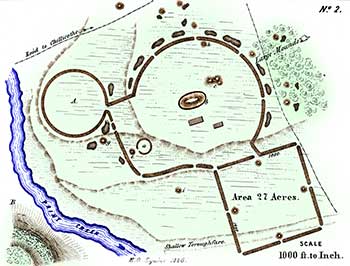
|
| E.G. Squier's Survey of the Seip Earthworks. |
The Seip Group
Location: Seip Mound is located 14 miles southwest of Chillicothe and two miles east of Bainbridge, on U.S. Route 50 in Ross County.Seip Mound is the second largest earthen mound built by the Native American Hopewell people and is listed on the National Register of Historic Places. The mound is 240 feet long, 130 feet wide, and 30 feet high. Originally, Seip Mound was surrounded by a large 121 acre earthwork complex with 10,000 feet of embankment walls most of which are now destroyed. Originally the walls stood nearly 10 feet in height and 50 feet wide at the base. Seip mound was in the center of a large, semi-circular enclosure with a smaller circular enclosure to the west and a square to the south. Fortunately, E.G. Squier surveyed the complex in 1846 as shown in the adjacent map. Squier describes the earthworks as follows:
Within the larger circle, and not far from its centre, is a large elliptical mound, two hundred and forty feet long by one hundred and sixty broad, and thirty in height. It is considerably larger than any other single mound in the valley, and covers a little more than two thirds of an acre. It seems to be composed, at least towards the surface, of stones and pebbles,—a feature peculiar to a certain class of mounds, of a highly interesting character. It is surrounded by a low, indistinct embankment, the space between which and the mound seems to have been raised by the wasting of the latter. Perhaps this was a low terrace. To the right of this fine mound is a group of three others in combination, as shown in the plan at 'c'. There are several other small mounds in and around the work. Several very large and beautiful ones, composed entirely of clay, occur about one fourth of a mile distant, in the direction indicated in the plan.The entire work is surrounded by deep pits or excavations, usually called "wells," from which the materials for the mounds and embankments were procured. So numerous are these, and such serious obstacles are the mounds and embankments to cultivation, that a deduction of several acres is allowed to the tenant in consequence, by the lease of the estate upon which they occur. The small circle at 'a'' is two hundred and fifty feet in diameter. It has been so much reduced by the plough as to be traced with difficulty.
Between 1906 and 1909, the Ohio Historical Society excavated the three connected mounds shown in Squiers survey at point 'c'. Between 1925 and 1928 the Ohio Historical Society excavated Seip mound. In the book "The Mound Builders," Henry Clyde Shetrone describes the excavations as follows:
The central mound of the Seip Group is second in size of all known Hopewell tumuli, being exceeded only by the great central mound of the Hopewell Group proper. It measured 250 feet in length, 150 in width, and had a height of 30 feet. The cubic content of this great tumulus was approximately 20,000 cubic yards, the equivalent of as many ordinary wagonloads of earth. Three full summers were required for its examination.The most striking feature of the examination was the finding of an interior sepulcher or vault, constructed of logs and timbers, in which reposed four adult skeletons, placed side by side and extended on their backs, while lying at their heads, transversely, were the skeletons of two infants (Figure 138). Whether or not this was a family tomb or a sepulcher devoted to the "royalty" of the community, it is indisputable that the occupants were of the elect. The burials were accompanied by a rich array of artifacts, some of which were unique. There were thousands of pearls, from which circumstance newspaper reports at the time designated the interments as the "great pearl burial." Implements and ornaments of copper, mica, tortoise-shell, and silver were found in profusion. A single individual, an adult male, wore the same type of artificial nose and the copper rodlike hair ornaments found in the double burial of the Hopewell Group. Imprints of an elaborate burial robe were apparent, and beneath and preserved by large copper breastplates accompanying three of the four adults portions of this shroud were well preserved. The burial robe or shroud, of woven fabric, proved to be a unique find in that it bore colored designs (Figure 53). These designs, conventional in character, were in tan, maroon, and black.
Two important votive offerings occurred in the central Seip Mound. In one of these reposed a huge ceremonial copper axe weighing 28 pounds (Figure 140). Over this were placed twelve large copper breastplates, overlapping one another, and between them were many thicknesses of woven fabric (Figure 36). This fabric, preserved by the chemical action of the copper, is very similar in weave, texture, and color to the homespun linen of pioneer days. It is perhaps the only woven fabric preserved in its original color and practically unstained so far taken from a mound. The other votive offering was the five massive effigy pipes of the Lower Mississippi culture...
One accident occured during the Seip mound excavation. A portion of the mound had been removed leaving a 30 ft. high vertical wall. Part of the top caved off burying Dr. Shetrone under a pile of rubble. He was unconcious and received numerous broken bones but made a full recovery. After excavation, Seip mound was restored and preserved. The Ohio Historical Society owns the central section of the earthworks and the National Park Service owns the surrounding property which includes some remains of the enclosure.
